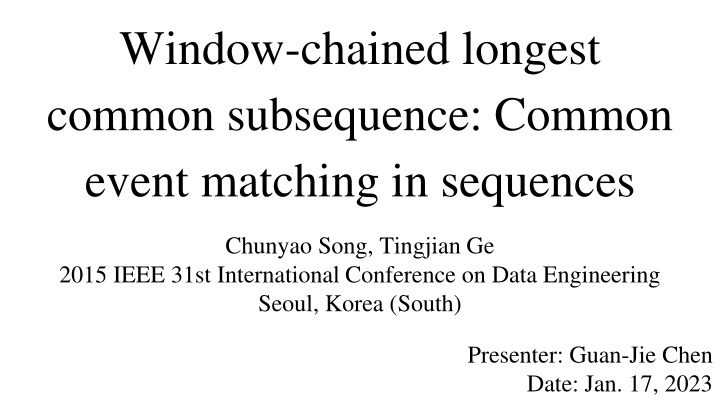
Discovering Window-Chained Longest Common Subsequence Problem
Explore the innovative approach of the window-chained longest common subsequence (WCLCS) problem in event matching sequences. This research addresses the challenges of identifying common event subsequences within long sequences, presenting efficient algorithms and methods for improved performance in various domains.
Download Presentation

Please find below an Image/Link to download the presentation.
The content on the website is provided AS IS for your information and personal use only. It may not be sold, licensed, or shared on other websites without obtaining consent from the author. If you encounter any issues during the download, it is possible that the publisher has removed the file from their server.
You are allowed to download the files provided on this website for personal or commercial use, subject to the condition that they are used lawfully. All files are the property of their respective owners.
The content on the website is provided AS IS for your information and personal use only. It may not be sold, licensed, or shared on other websites without obtaining consent from the author.
E N D
Presentation Transcript
Window-chained longest common subsequence: Common event matching in sequences Chunyao Song, Tingjian Ge 2015 IEEE 31st International Conference on Data Engineering Seoul, Korea (South) Presenter: Guan-Jie Chen Date: Jan. 17, 2023
Abstract (1 / 3) Sequence data is prevalent, and event processing over sequences is increasingly important in this Big Data era, drawing much attention from both research and industry. In this paper, we address a novel problem, which is to find common event subsequences from two long sequences. This problem is well motivated, with applications in diverse domains. 2
Abstract (2 / 3) We propose the window-chained longest common subsequence (WCLCS) semantics, and argue that the traditional longest common subsequence (LCS) cannot serve this need. We then devise efficient algorithms to solve this problem by reducing it to a graph problem. 3
Abstract (3 / 3) We also propose two more methods to improve the performance: one is based on informed search and exploration, and the other is an approximation algorithm with accuracy guarantees. We finally carry out a systematic experimental evaluation using two real-world datasets and some synthetic datasets. 4
Constraints minimum density: maximum gap: maximum shift: 5
WCLCS Step1. Obtain the longest common subsequence within each two-dimensional time window (WLCS) - - PerWinLCS1 PerWinLCS2 7
PerWinLCS1 w = 3 8
PerWinLCS2 c[1] = 1 c[2] = 1 c[3] = 2 w = 3 9
WCLCS Step2. Find an optimal chain of windows that satisfy the constraints - - WCLCS-AnyGap WCLCS-MaxGap 10
Converting the WCLCS Selection into a Graph Problem (1 / 2) no edge from 6 to 3 since the two windows overlap no edge from 8 to 5 since they are beyond the maximum gap allowed11
Converting the WCLCS Selection into a Graph Problem (2 / 2) with all weights negated, it becomes a single-source shortest path problem (can be solved by Bellman-Ford) 12
WCLCS-AnyGap w = 2 14
WCLCS-MaxGap (1 / 2) w = 2 ???? = 1 scan [(? ? ????, ? ? ????), (? ?, ? ?)] 15
WCLCS-MaxGap (2 / 2) It may involve a large number of spatial index operations when the number of matching windows is large Solution: WCLCS-Astar 16
WCLCS-Astar (1 / 5) Storing a set of window chains (most of which are partial) in a priority queue, where the priority of a window chain ? can be written as ?(?) = ?(?) + (?) ?(?): the total matching length of the windows in ? (?): an upper bound of the total matching length of the windows that could potentially be added to chain ? ?(?): an upper bound of any potential window chain derived from ? 17
WCLCS-Astar (2 / 5) (?) = ???(?, ?) ?(?, ?) 18
WCLCS-Astar (3 / 5) Step1. Pop the maximum priority chain C from the priority queue Step2. - If there exists preceding windows: For each preceding window, we prepend it to ? and add the new chain to priority queue, then update (?) - If not: Set (?) to 0 and add C to the priority queue 19
WCLCS-Astar (4 / 5) Step3. Recursively do step1. and step2, if the popped chain C has (?) = 0, it must be the WCLCS 20
